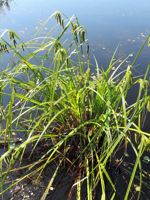Mon-Fri 9am - 5pm Mountain time
Tall Manna Grass vs Cyperus-like Sedge
Glyceria grandis
Carex pseudocyperus
CUSTOM GROW
CUSTOM GROW
Manna Grass and other waterside plants are an excellent way to prevent erosion and provide habitat and forage for animals. The difference is that Manna Grass looks better doing it! With distinctive purple grains at the top of its stalks, Manna Grass adds a splash of color to the waterside that most other aquatics can't offer.
Manna Grass is good for returning disturbed sites to nature and provides nourishment to many animals, except for cattle who find it toxic.
Cyperus-like Sedge is a native perennial sedge found in wetlands, marshes, swamps, and along shorelines. Classified as an obligate wetland species, it grows in dense clumps that thrive in saturated soils, helping stabilize wet ground and protect shorelines. These colonies also provide cover for wildlife, while the seeds may be eaten by waterfowl and other birds. It is well-suited to wetland restoration, waterside and riparian zone plantings, and naturalization projects.
Its ornamental appeal comes from the contrast between the upright male floral spikes at the top of the stems and the long, drooping female floral spikes that hang below. These seed spikes resemble those of Cyperus species, giving the plant its common name and making it an attractive addition to naturalized plantings.
Tall Manna Grass Quick Facts
Cyperus-like Sedge Quick Facts
Toxicity: toxic to cattle

